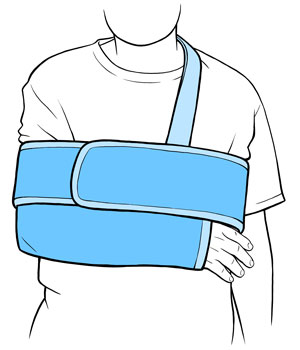A sling and swathe is used to support your arm and hold it closely against your body after an injury. It's used for injuries where moving the shoulder joint could cause harm. For instance, it would be used after a shoulder dislocation or shoulder fracture.
A joint that is kept still for too long can become stiff and lose range of motion. Follow up with your health care provider as advised. Don’t use the sling longer than directed.
Home care
-
Leave the sling and swathe in place as long as directed by your health care provider. Unless told otherwise, you should sleep with it in place.
-
If you're being treated for a shoulder dislocation, you may take the sling and swathe off to bathe or dress. Don't try to raise your arm away from your body. Put it back on as soon as possible.
-
Your provider may advise gentle pendulum exercises. Stand or sit with your arm hanging straight down and close to your side. Relax your shoulder muscles and gently swing the arm forward and back, side to side, and in small circles for about 5 minutes. Do this 1 or 2 times a day. There should be only slight pain with this exercise.
-
If you're being treated for a shoulder fracture, leave the sling and swathe in place until your next exam.
-
The sling and swathe is adjustable. If it gets loose, adjust the sling so that your forearm is level with the ground. Your hand should be level with the elbow. Adjust the part that wraps around your body, called swathe, so that your arm is held snugly against your body.
When to get medical advice
Contact your health care provider right away if you have:
-
New or worsening symptoms.
-
Questions about adjusting the sling and swathe.


